Tattoos
What Do Grape Tattoos Symbolize?

What Do Grape Tattoos Symbolize?
Grape tattoos have gained popularity in the tattoo world due to their rich symbolism and aesthetic appeal. Employed in both traditional designs and modern artwork, these tattoos inspire thoughts of nature, abundance, and various cultural meanings. This article will explore the symbolism behind grape tattoos and the significance they hold to individuals.
Rich History of Grape Symbolism
Grapes have been an integral part of human culture for centuries. Associated with various myths and legends, they carry a weight of history that enhances their meaning in tattoos. Ancient civilizations celebrated grapes for their versatility, using them to produce wine, one of the oldest beverages known to humanity. In ancient Greece, the grape vine was linked to Dionysus, the god of wine, fertility, and revelry. This connection to joy and celebration helps explain why many choose grape tattoos to represent happiness and abundance in their lives.
Furthermore, grapes symbolize prosperity and growth. The lifecycle of the grape starting from a tiny seed to a fruitful vine speaks of patience, nurturing, and the rewards that come from hard work. This intricate relationship with growth makes grape tattoos appealing to those who value personal development and success. As symbols of abundance, they remind individuals to appreciate the fruits of their labor.
Connection to Fertility and Prosperity
In various cultures, grapes symbolize fertility and prosperity due to their association with bountiful harvests. Farmers and agricultural societies often relied on grape cultivation, tying the success of their crops to their livelihood. For many, a grape tattoo is a reminder of their roots, honoring their ancestry, and the fertility of land that sustains us. It is a tribute to the nourishment the earth provides and a representation of one’s commitment to using their resources wisely.
Also Read: The Spiritual Symbolism of the Left Foot Understanding its Importance

Grapes also represent the cyclical nature of life and the interconnectedness of all things. Just as a vineyard must be tended to for the grapes to flourish, individuals must nurture their lives and relationships for them to thrive. A grape tattoo could then serve as a reminder to stay mindful of one’s environment and the importance of balance for sustainable growth.
Spiritual Significance of Grapes
Many individuals identify grapes with spirituality and enlightenment. In Christianity, grapes and wine often symbolize the blood of Christ and are a central theme during communion ceremonies. This deep spiritual link makes grape tattoos not just an artistic choice but also a statement of faith and conviction. For those who feel a connection to their beliefs, grape tattoos can be a powerful representation of their spirituality.
Additionally, grapes embody the idea of abundance in spiritual journeys. Many belief systems emphasize the importance of abundance and gratitude in attracting positive energy. People who choose grape tattoos may see them as an emblem not only for their material prosperity but also for the richness of experiences life offers. As a spiritual symbol, grapes remind people that they are in sync with their surroundings and that growth and abundance stem from deeper understanding and appreciation.
Aesthetic Appeal of Grape Tattoos
Beyond the deep symbolic meanings, grape tattoos are also appealing for their aesthetic quality. The intricate details of grape clusters, with varying shades of purple and green, allow for stunning artistic design. Many tattoo artists can transform grape tattoos into beautiful pieces of body art, ranging from realistic portrayals to abstract interpretations.
This versatility means that grape tattoos can be tailored to fit different personal styles. Some prefer minimalist designs, while others might opt for elaborate, colorful artwork. This adaptability has made grape tattoos a favorite choice for individuals looking to express themselves through body art.

Grape Tattoos in Different Cultures
Grape tattoos carry unique meanings in various cultures, enriching their symbolism even further. For instance, in some Asian cultures, grapes signify wealth and are often regarded as symbols of abundant blessings. Consequently, a grape tattoo could encapsulate these meanings, allowing the wearer to connect with their cultural heritage.
In contrast, Italian and Mediterranean cultures hold grapes in high esteem, given their significance in wine making traditions. For Italians, a grape tattoo may symbolize a love for family gatherings, feasting, and enjoying life’s pleasures. Hence, grape tattoos can serve as cultural connectors, reminding individuals of their lineage and shared traditions.
Personal Meaning Behind Grape Tattoos
Many people choose grape tattoos based on personal interpretations and life experiences. For some, the tattoo may represent a cherished memory related to wine, family gatherings, or moments of celebration. It could be a reminder of time spent in vineyards during special occasions or festivals. These personal connections to grapes add layers of meaning to the tattoo, making them all the more special.
In relationships, grapes may symbolize growth and harmony. Couples who share a love for wine or those who have experienced significant life changes might choose grape tattoos as a testament to their journey together. This shared symbolism emphasizes the role of grapes as a bonding element, reminding individuals of the importance of nurturing relationships over time.
Grape Tattoo Designs and Styles
The design of grape tattoos can vary widely, catering to diverse tastes and preferences. Some popular designs include realistic grape clusters, vine patterns, or abstract interpretations. Other individuals opt for designs combining grapes with other elements, such as flowers or leaves, creating a more intricate and personalized tattoo. Color usage also plays a critical role in the aesthetic appeal of grape tattoos. The deep purples and verdant greens give these designs a lively, fresh look.
Tribal tattoo styles also showcase grape designs, incorporating traditional patterns and motifs that hold cultural significance. These designs often reflect the rich heritage and history behind the grape, grounding individuals’ personal stories in broader cultural narratives. The choice of style should align with the wearer’s taste and intention, whether for artistic expression or symbolism.
Popular Placement for Grape Tattoos
When selecting a tattoo, the placement can add to its meaning and visibility. Common areas for grape tattoos include the arms, shoulders, and back. The choice of placement often depends on personal preference and the size of the design. For instance, larger, intricate designs may be better suited for visible areas, while smaller, subtle tattoos could work well on wrists or ankles.

The placement also affects how the tattoo may be perceived by family, friends, and colleagues. Individuals often weigh these factors when deciding where to place their tattoos, ensuring that they express their identity while considering social or professional contexts.
Conclusion
Grape tattoos are rich in symbolism, encompassing themes of abundance, growth, spirituality, and cultural significance. Their aesthetic appeal further adds to their popularity in the tattoo community. Whether connected to personal memories, cultural heritage, or agricultural traditions, grape tattoos serve as timeless expressions of individuality and shared experiences. Those who choose to get grape tattoos carry with them stories of their journeys, making these designs not just art but also meaningful statements about life, love, and the beauty of nature.
FAQs
1. What do grape tattoos typically represent?
Grape tattoos generally symbolize abundance, prosperity, growth, fertility, and spirituality, rooted in cultural and historical significance.
2. Why do people choose grape tattoos specifically?
Individuals often choose grape tattoos for personal connections, aesthetic appeal, cultural significance, or to symbolize growth and celebration in their lives.
3. Can grape tattoos be combined with other designs?
Yes, grape tattoos can be creatively combined with other elements, such as flowers, vines, or meaningful symbols, to enhance their significance and artistry.
4. Are there specific color meanings associated with grape tattoos?
The colors of grapes, typically rich purples and greens, can symbolize harvest, prosperity, and vitality in various cultural contexts.
5. How do grape tattoos differ in meaning across cultures?
While grapes universally symbolize abundance and growth, they can carry unique meanings in different cultures, such as wealth in Asian cultures or family ties in Mediterranean traditions.
Tattoos
Medusa Tattoo Meaning Decoding Myth Power & Feminine Symbolism in Modern Body Art

Medusa Tattoo Meaning Decoding Myth Power
The Medusa tattoo has surged in popularity, evolving from a niche mythological motif to a bold symbol of empowerment, resilience, and spiritual transformation. But what fuels its allure? Is it the haunting beauty of Medusa’s serpent-crowned visage, or the deeper narrative of a woman wronged and reclaimed? This article dives into the Medusa tattoo meaning, unpacking its roots in Greek mythology, its ties to feminine power, and its modern reinterpretation as a spiritual emblem. Whether you’re considering your first tattoo or seeking to decode its symbolism, this guide illuminates why Medusa’s story resonates across time and skin.
The Mythological Roots of Medusa From Ancient Scorn to Modern Icon
Medusa’s Origins in Greek Lore More Than a Monster
Medusa’s story begins in Greek mythology as one of the three Gorgons, but her narrative is layered with tragedy and cultural commentary:
- Pre-Ovidian vs. Ovid’s Medusa: In Hesiod’s Theogony, Medusa is born a monster, while Ovid’s Metamorphoses reframes her as a victim of divine abuse. This shift highlights how ancient storytellers grappled with themes of power and victimhood.
- Athena’s Role: Athena’s punishment of Medusa (turning her hair to snakes) is often interpreted as jealousy or a patriarchal enforcement of purity culture.
- Perseus’ Quest: Medusa’s beheading by Perseus, aided by Athena and Hermes, symbolizes the triumph of “heroic” masculinity over feminine chaos a trope later challenged by feminist scholars.

Medusa in Ancient Art & Religion Protector, Not Just a Villain
Archaeological evidence reveals Medusa’s dual role in antiquity:
- Apotropaic Symbol: Her face adorned shields, temples, and coins to ward off evil (e.g., the Gorgoneion on Athena’s shield).
- Connection to the Underworld: Some cults linked her to Persephone, goddess of the underworld, framing her as a guardian of life-death cycles.
- Feminine Rage in a Patriarchal World: Medusa’s monstrous form mirrors societal fears of women’s unrestrained power, a theme explored in Mary Beard’s Women & Power.
Modern Reclamation How Feminism Reshaped Medusa’s Legacy
- Elana Dykewomon’s Poetry: 1970s feminist works reimagined Medusa as a survivor reclaiming her voice.
- Modern Media: Films like Percy Jackson and games like Hades depict her sympathetically, contrasting her with toxic gods like Poseidon.
- Tattoos as Protest: Survivors of assault ink Medusa to publicly reject shame, inspired by the 2018 “Medusa Tattoo Project.”
The Spiritual & Symbolic Layers of a Medusa Tattoo Beyond Aesthetics
Also Read: The Spiritual Symbolism of the Eyes Gateway to the Soul
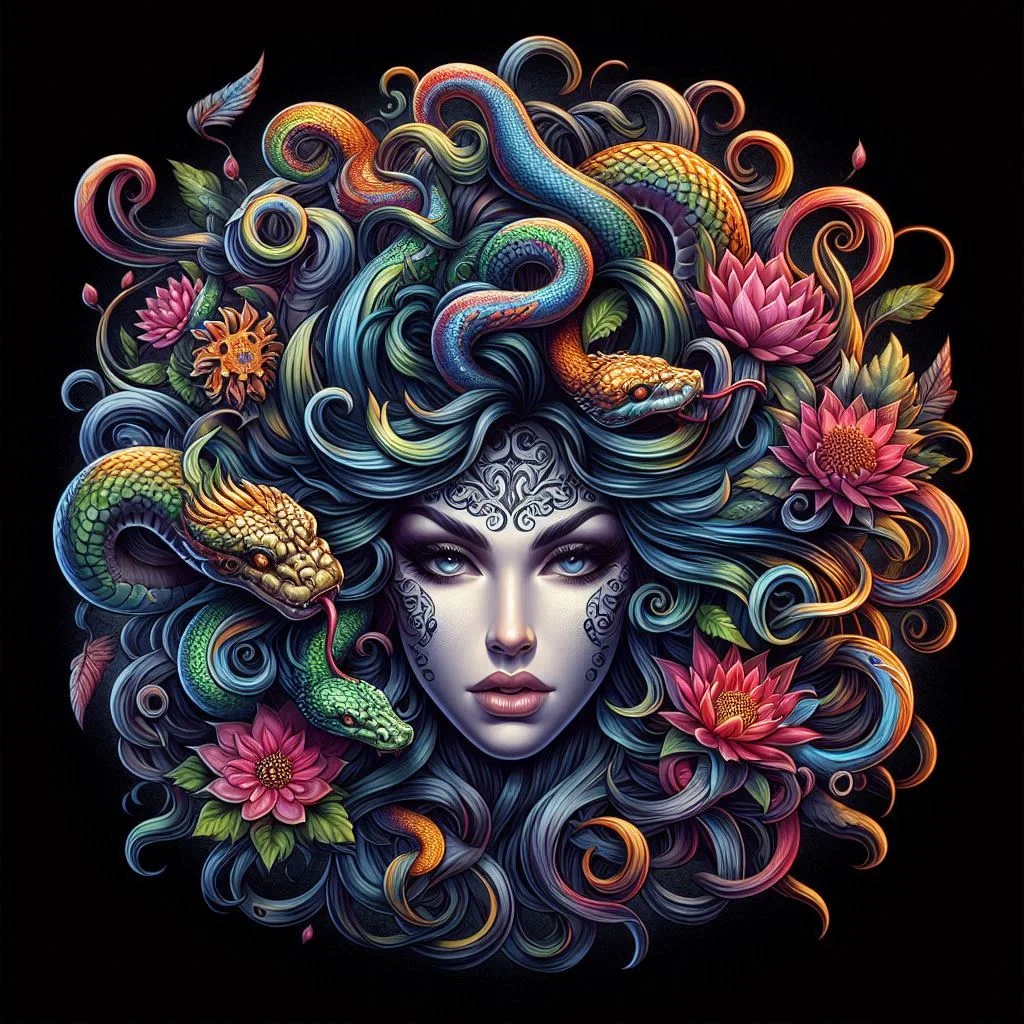
Medusa as a Spiritual Archetype Shadow Work & Empowerment
In spirituality, Medusa’s symbolism intersects with Jungian psychology and mysticism:
- Shadow Integration: Her snakes represent confronting repressed trauma or “dark” emotions to achieve wholeness.
- Divine Feminine Energy: Linked to Lilith (Hebrew mythology) and Durga (Hinduism), she embodies unapologetic feminine force.
- Third Eye Activation: Her piercing gaze mirrors the “evil eye” motif, symbolizing intuition and spiritual awakening.
Protection Symbolism From Ancient Amulets to Modern Rituals
Medusa tattoos often serve as talismans:
- Warding Off the “Evil Eye”: In Mediterranean cultures, her image deflects envy and ill intent.
- Boundary-Setting: For survivors, the tattoo acts as a “shield” against emotional or physical violation.
- Memento Mori: Her association with death reminds wearers of life’s fragility, encouraging mindful living.
Duality & Transformation The Snake as a Multifaceted Symbol
- Rebirth: Snakes shedding skin align with Medusa’s story of surviving transformation.
- Danger vs. Wisdom: Vipers (danger) vs. cobras (divine protection in Egyptian lore) allow personalized meanings.
- Balance: Medusa’s blend of beauty and horror mirrors the Taoist yin-yang philosophy.
Popular Medusa Tattoo Designs & Their Meanings A Visual Guide
Style Breakdown Matching Aesthetics to Intent
- Neo-Traditional: Bold lines and vibrant colors (e.g., red snakes) emphasize power and drama.
- Blackwork/Trash Polka: High-contrast designs symbolize chaos and resilience.
- Minimalist Line Art: Single-line snakes or silhouettes appeal to subtlety seekers.
Symbolic Add-Ons Elevating the Narrative
- Blood Tears: Signify mourning or survival.
- Broken Chains: Represent liberation from abuse or societal expectations.
- Celestial Motifs: Moons (feminine cycles) or stars (guidance) add spiritual depth.
Cultural Fusion Designs Global Interpretations
- Medusa x Japanese Irezumi: Serpents styled as traditional hebi (snake) tattoos for longevity themes.
- African Tribal Patterns: Combining Medusa with Adinkra symbols like Akoma (endurance).
- Mexican Sugar Skull Medusa: Blending Dia de los Muertos imagery with her story of death/rebirth.
Choosing the Right Medusa Tattoo A Step by Step Guide
Aligning Design with Personal Journey
- Trauma Survivors: Opt for designs with protective elements (shields, swords) or soft accents (flowers) to balance intensity.
- Spiritual Seekers: Incorporate sacred geometry (mandalas, Metatron’s Cube) or chakra colors.
- Feminist Statements: Pair Medusa with slogans like “Nevertheless, She Persisted” or Venus symbols.

Technical Considerations Placement, Size, and Skin Tone
- Dark Skin Tones: Use bold colors like emerald green or gold for visibility.
- Pain Tolerance: Ribcage and spine hurt most; consider forearm or thigh for intricate work.
- Aging Gracefully: Avoid tiny details on high-friction areas (hands, feet).
Collaborating with Your Artist Questions to Ask
- “Can you blend realism with abstract elements?”
- “Have you worked with mythological themes before?”
- “How will this design age over time?”
Medusa Tattoo FAQs Addressing Unique Concerns
1. “Will people misinterpret my Medusa tattoo as ‘evil’?”
Contextualize it with uplifting symbols (phoenixes, sunrises) to clarify intent.
2. “Can I incorporate my cultural heritage into a Medusa design?”
Yes! Example: A Maori-inspired Medusa with koru (spiral) snakes for growth.
3. “Is it disrespectful to tattoo Medusa if I’m not Greek?”
Focus on universal themes (empowerment, resilience) rather than caricaturing her myth.
4. “How do I explain my Medusa tattoo to employers?”
Opt for discreet placements (upper back, ribs) or abstract designs that avoid graphic imagery.
5. “What if my tattoo triggers past trauma?”
Work with a therapist and artist to design a symbol of reclaiming agency, not reliving pain.
Conclusion
The Medusa tattoo is a living tapestry of myth, spirituality, and personal triumph. By understanding its rich layers from ancient apotropaic amulets to modern survivor solidarity you can craft a design that’s not just skin-deep, but soul-deep.
Tattoos
What Does a Dragonfly Tattoo Symbolize?

What Does a Dragonfly Tattoo Symbolize?
Dragonfly tattoos have become increasingly popular in recent years, representing various meanings and emotions. These delicate insects are not only visually striking but also rich in symbolism. A dragonfly tattoo can represent change, transformation, adaptability, and even the connection to nature or the spiritual realm. As we explore the meaning of dragonfly tattoos, we will also delve into their popularity and cultural significance.
The Beauty of Dragonflies
Dragonflies are mesmerizing creatures. Their vibrant colors and graceful movements capture the attention of many. These insects have been around for millions of years, thriving in various environments. Their beauty is not just in their appearance but also in their unique life-cycles and behaviors.
The dragonfly’s wings, often found in an array of colors, display both strength and delicacy. The way they hover and dart through the air symbolizes agility and precision. As a tattoo choice, they represent not only aesthetic beauty but also a deeper connection to nature. This makes dragonfly tattoos appealing to individuals who appreciate the natural world and its wonders.
Symbol of Change and Transformation
One of the primary meanings associated with dragonflies is change and transformation. The life cycle of a dragonfly is a perfect illustration of this concept. They start as nymphs living underwater, undergoing several molts until they emerge as beautiful winged insects. This transformative journey serves as a reminder that change is an essential part of life.
Many people who choose a dragonfly tattoo do so as a celebration of personal growth. It can symbolize overcoming challenges, embracing new opportunities, or simply navigating life’s ups and downs. The dragonfly’s ability to adapt to its environment reflects resilience and flexibility, qualities that are admirable in any individual.
Also Read: What is the spiritual meaning of a shooting star?

Connection with Nature
Dragonflies are often found near water, making them a symbol of nature’s beauty and serenity. A dragonfly tattoo can signify a deep connection to the natural world, emphasizing the importance of preserving the environment. It serves as a reminder to appreciate the simple beauty around us, encouraging mindfulness in our daily lives.
This connection with nature can extend beyond the individual. Some people choose dragonfly tattoos to represent their desire to protect the natural world or to align themselves with Eco-friendly values. By getting a tattoo of a dragonfly, individuals can express their commitment to sustainability and the health of the planet.
Spiritual Significance
In various cultures, dragonflies hold spiritual meanings that can influence why someone might choose a dragonfly tattoo. In some Native American traditions, dragonflies are symbols of renewal and living in the moment. They are seen as messengers, representing a close connection to spiritual realms.
This spiritual symbolism can resonate with individuals seeking to awaken their inner selves or connect with something greater. A dragonfly tattoo can serve as a personal totem, guiding them on their spiritual journey. It invites reflection and encourages an exploration of one’s beliefs and values.
Representing Lightness and Joy
Dragonflies are often associated with lightness and joy due to their playful movements and vibrant colors. They are creatures that flit through the air with ease and grace, embodying a carefree spirit. A dragonfly tattoo can symbolize the pursuit of happiness and a reminder to embrace life’s joyful moments.
In stressful times, a dragonfly motif can serve as a beacon of hope. It encourages individuals not to take life too seriously and to find joy even in small things. This aspect of the dragonfly’s essence makes it a popular choice for tattoos among those who value positivity and optimism.
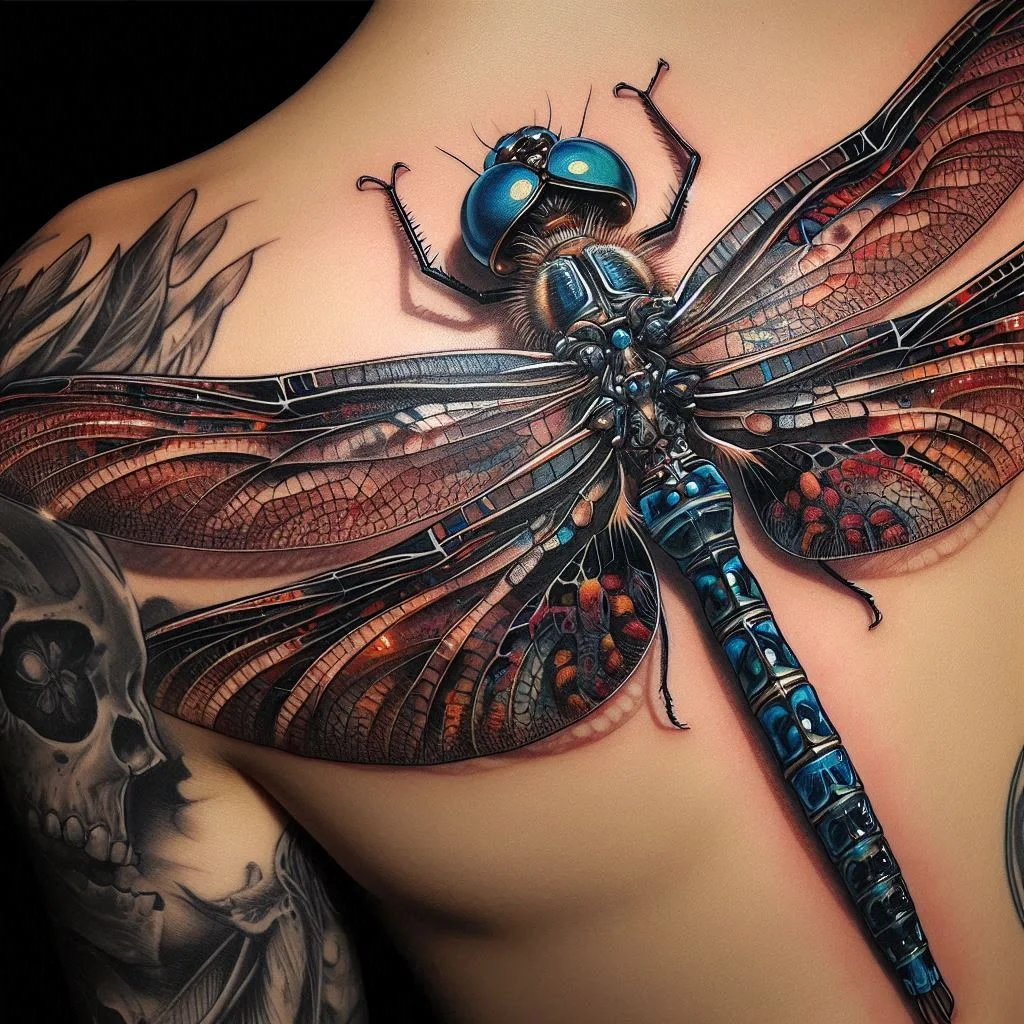
A Reminder of the Present Moment
Another powerful symbolism of dragonflies is their ability to remind us to live in the present. Dragonflies have a short lifespan, usually only a few months. Their brief existence encourages us to appreciate every moment, savoring life’s experiences rather than getting lost in past regrets or future anxieties.
A dragonfly tattoo can be a beautiful expression of this philosophy. It can inspire wearers to embrace the present, urging them to make the most of today. This reminder can be particularly meaningful for those going through significant life changes or challenges, serving as an anchor in turbulent times.
Elegance and Aesthetics
Aside from their deep meanings, dragonflies are simply beautiful creatures. A dragonfly tattoo can be an eye-catching piece of art that represents one’s personal style. With their intricate details and stunning colors, dragonflies can be designed in a multitude of ways—from realistic depictions to stylized interpretations.
Choosing a dragonfly tattoo allows for creative expression. People can customize their designs to reflect their personalities. The elegance of a dragonfly makes it a versatile tattoo option that can be placed anywhere on the body—such as the wrist, shoulder, or back—allowing for endless possibilities in terms of size and design.
Cultural Representation
Different cultures have varying perspectives on dragonflies, which can further enrich the meaning behind a tattoo. In Japan, for example, dragonflies are symbols of strength and courage. They are associated with warriors and are often included in traditional Japanese art. In contrast, Celtic folklore views dragonflies as a sign of happiness and light.
For individuals who have a fondness for cultural symbolism, a dragonfly tattoo can be a way to honor these rich traditions. It can serve as a bridge to their heritage or as an expression of admiration for the beliefs of other cultures.
Choosing the Right Design
When considering a dragonfly tattoo, the design itself plays a significant role in conveying the intended meaning. Simple silhouettes can represent elegance and minimalism, while elaborate designs with detailed wings can signify a connection to intricate beauty and transformation.
Colors also impact the symbolism of the tattoo. Bright colors may evoke a sense of joy or playfulness, while darker hues can imply depth and seriousness. This versatility allows individuals to choose a design that resonates with their personal story and values.
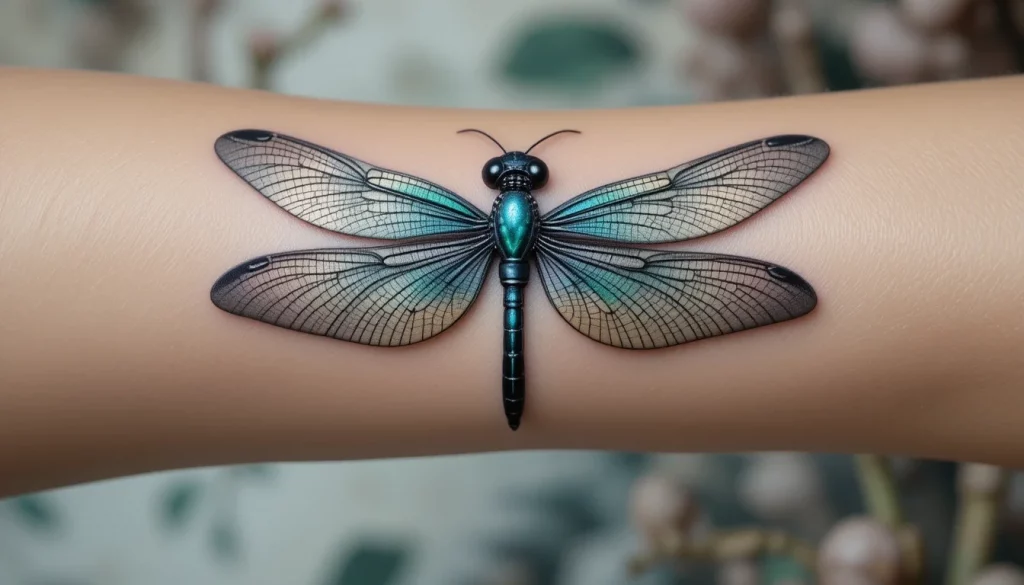
Final Thoughts
Choosing a dragonfly tattoo can be a meaningful decision that reflects personal growth, connection to nature, spirituality, and the joy of living in the moment. Each tattoo tells a unique story and can serve as a reminder of the values and beliefs that are important to the wearer.
As the popularity of dragonfly tattoos continues to rise, they remain timeless symbols that encapsulate the beauty of transformation and the essence of life itself. Whether chosen for aesthetic appeal or profound meaning, a dragonfly tattoo is a beautiful expression of individuality and connection to the world.
FAQs
1. Are dragonfly tattoos suitable for both men and women?
Yes, dragonfly tattoos are popular among both men and women. Their beauty and symbolism resonate with a wide range of people, making them a versatile choice for anyone.
2. How can I care for my dragonfly tattoo?
Proper aftercare is crucial for your tattoo’s healing. Keep the area clean, avoid excessive sun exposure, and apply a fragrance-free moisturizer. Follow your tattoo artist’s specific aftercare guidelines for the best results.
3. Can I incorporate other elements with my dragonfly tattoo?
Absolutely! Many people choose to combine dragonflies with flowers, water elements, or other symbols that hold personal meaning. This can enhance the overall design and symbolism of your tattoo.
4. What is the best placement for a dragonfly tattoo?
The placement of a dragonfly tattoo is a personal choice. Common areas include the wrist, shoulder, back, and ankle. Consider where you want to display your tattoo and how visible you want it to be.
5. Do dragonfly tattoos have different meanings in other cultures?
Yes, dragonflies carry various meanings across cultures. For example, in some Native American traditions, they symbolize renewal, while in Japanese culture, they represent strength and courage.
Tattoos
What Does a Water Dragon Tattoo Symbolize
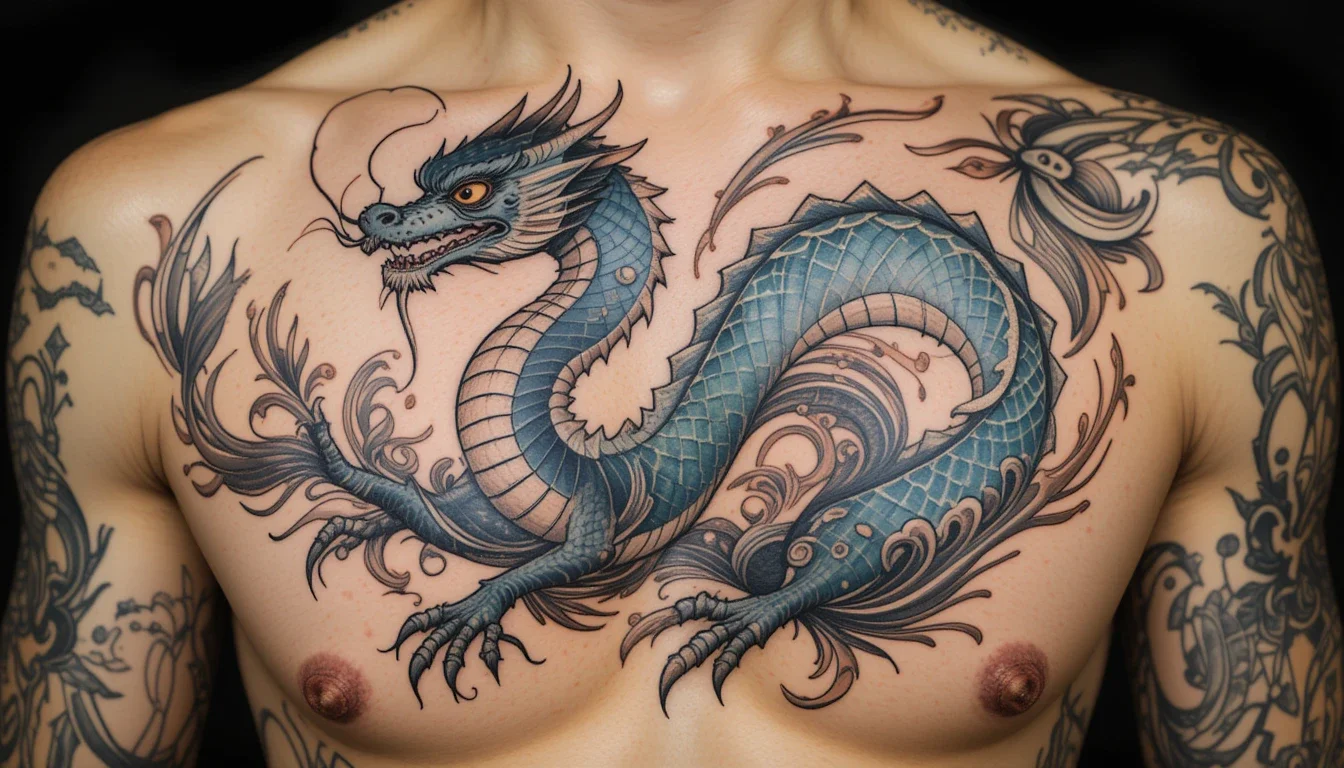
What Does a Water Dragon Tattoo Symbolize
Water dragon tattoos are both mystical and profound. They draw influence from various cultures, particularly those in East Asia, where the water dragon is regarded as a symbol of power, strength, and creativity. In this article, we will delve into the different aspects of water dragon tattoos, exploring their meanings, history, and cultural significance.
The Origins of Water Dragon Symbolism
Water dragons have deep roots in various mythologies and folklore. In Asian cultures, particularly in Chinese mythology, water dragons relate closely with water and its elemental power. Unlike traditional dragons, which often represent fire and strength, water dragons symbolize adaptability, fluidity, and life-giving properties.
Historically, water dragons were believed to have the authority over water bodies and were often invoked in prayers for rain and good harvests. These mythical beings resonate with the cyclical nature of life, embodying both creation and destruction. They are depicted in stories not just as ferocious creatures but also as wise protectors, reflecting the balance of nature.
Characteristics of the Water Dragon
One of the remarkable features of the water dragon is its dual nature. These creatures are often seen as both fierce and nurturing; they can bring floods that reshape landscapes, yet they also nourish the earth and sustain human life. This duality is a critical element when people choose to have a water dragon tattoo.
Further, the water dragon’s aesthetic differs from its fire-breathing counterparts. Their designs may incorporate flowing water, waves, clouds, and even aquatic symbols like koi fish. When someone selects a water dragon tattoo, they often gravitate towards designs that emphasize these fluid and graceful elements, evoking a sense of tranquility and movement.
Also Read: What is The Spiritual Significance of Finding Lizard in House
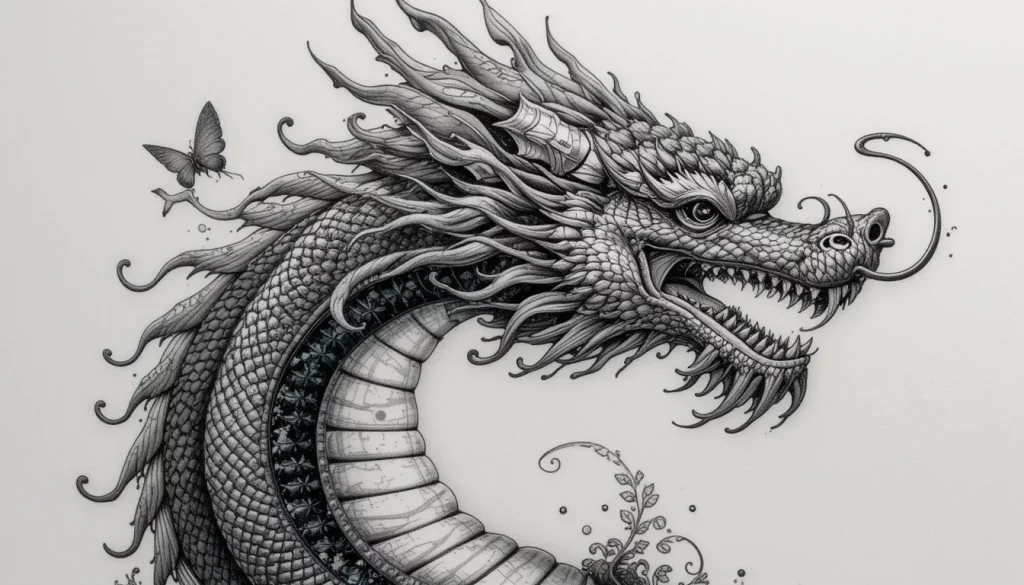
Cultural Significance of Water Dragon Tattoos
In various cultures, tattoos serve as more than just body art; they are imbued with meaning and representations of personal attributes. Water dragon tattoos are especially prevalent in Asian cultures, where they symbolize good fortune, protection, and balance in life.
For instance, in Chinese culture, having a water dragon tattoo might represent a person’s aspirations for wealth and success, as dragons are considered auspicious symbols. On the other hand, in Japanese culture, water dragons often represent wisdom, transformation, and spiritual strength. Their presence could be seen as a reminder to remain adaptable and resilient through life’s challenges.
Emotional and Spiritual Interpretations
On a more personal level, individuals may choose to tattoo a water dragon for emotional or spiritual reasons. The image of a water dragon can symbolize a powerful connection to one’s intuition and inner strength. The fluidity of the water represents emotions while the dragon conveys confidence.
People who have faced significant life changes or challenges often find solace in the imagery of water dragons. The tattoo serves as a reminder of their capacity to adapt and overcome obstacles. It may also represent a journey of personal transformation, reflecting the turbulent waters of life as a catalyst for growth.
Aesthetic Appeal and Tattoo Design
Tattoo enthusiasts are drawn to the beauty and intricacy of water dragon designs. The flowing form of a water dragon lends itself to creative tattoo artistry, allowing for vibrant colors, detailed scales, and swirling water motifs. Artists often depict these dragons in dynamic poses, suggesting movement through the very essence of water.
When considering the placement of a water dragon tattoo, individuals may gravitate toward larger areas of skin, such as their back, arms, or chest, to showcase the detailed artistry. The choice of colors, styles, and accompanying symbols can also enhance the tattoo’s meaning. Common elements include lotus flowers, waves, and clouds, each contributing additional layers of interpretation.
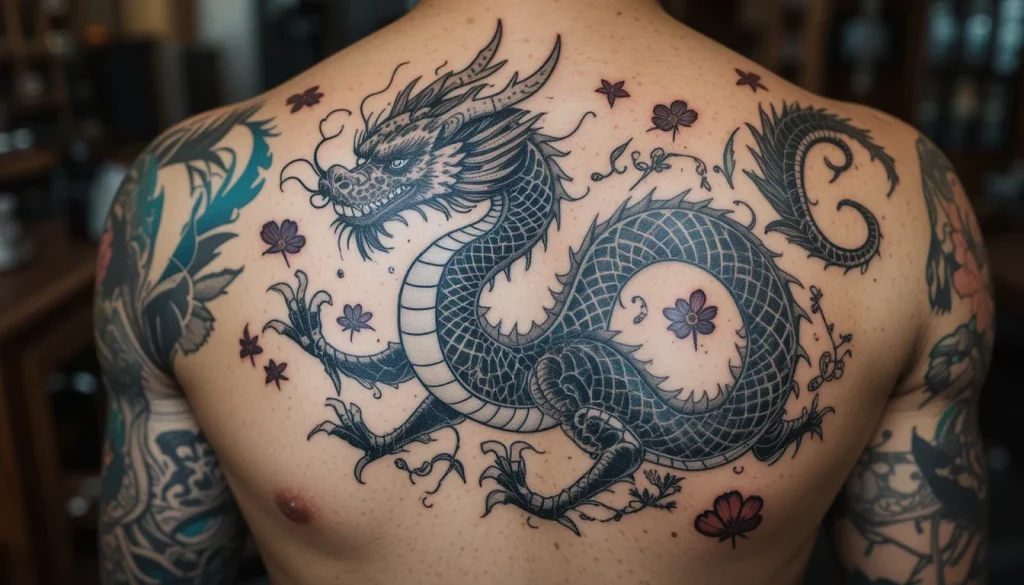
Personal Connection to Water Dragon Tattoos
Each individual’s connection to their water dragon tattoo may vary significantly. Some may view it as an emblem of their cultural heritage or a personal connection to mythology, while others may see it as a source of inspiration or empowerment. This personal association often plays a crucial role in the decision-making process when selecting a tattoo design.
For some, the water dragon represents aspirations, such as the pursuit of knowledge, wisdom, or success. Others may feel a deep spiritual connection, interpreting the water dragon as a guardian or guide in their lives. As tattoos are permanent, they often serve as lifelong reminders of various stages, achievements, or memories.
Choosing the Right Water Dragon Tattoo
Selecting a water dragon tattoo requires thoughtful consideration. It’s essential to think about what the design means to you personally and how it reflects your values and life experiences. Here are some aspects to contemplate:
Design Elements: Explore different styles, whether detailed realism or traditional Japanese art. Think about how you want the water dragon to be portrayed and what additional symbols or motifs might accompany it.Color Palette: Water dragons are often depicted in vibrant blues, greens, and teals. Consider how color can influence the mood and meaning of your tattoo.
Size and Placement: Evaluate where on your body you want the tattoo and its size. A larger tattoo might allow for more intricacy, while smaller designs might be more discreet.
- Artist Selection: Research tattoo artists who specialize in the style you’re interested in. Look at their portfolios and read reviews to ensure they can bring your vision to life.
Caring for Your Water Dragon Tattoo
Once you’ve chosen your water dragon tattoo and had it inked, caring for it properly is vital to ensure it remains vibrant and heals well. Proper aftercare can make all the difference in both the appearance of your tattoo and your skin’s health.
Follow Aftercare Instructions: Listen to your tattoo artist’s aftercare instructions diligently. This generally includes keeping the tattoo covered for a while, washing it gently with mild soap, and applying ointment.
Avoid Sun Exposure: Protect your tattoo from direct sunlight, especially in the initial healing phase. Once healed, using a high SPF sunscreen is advisable to prevent fading.
Keep it Moisturized: Keeping the tattoo moisturized can prevent itchiness during the healing process. Use fragrance-free lotion or ointment as recommended by your tattoo artist.
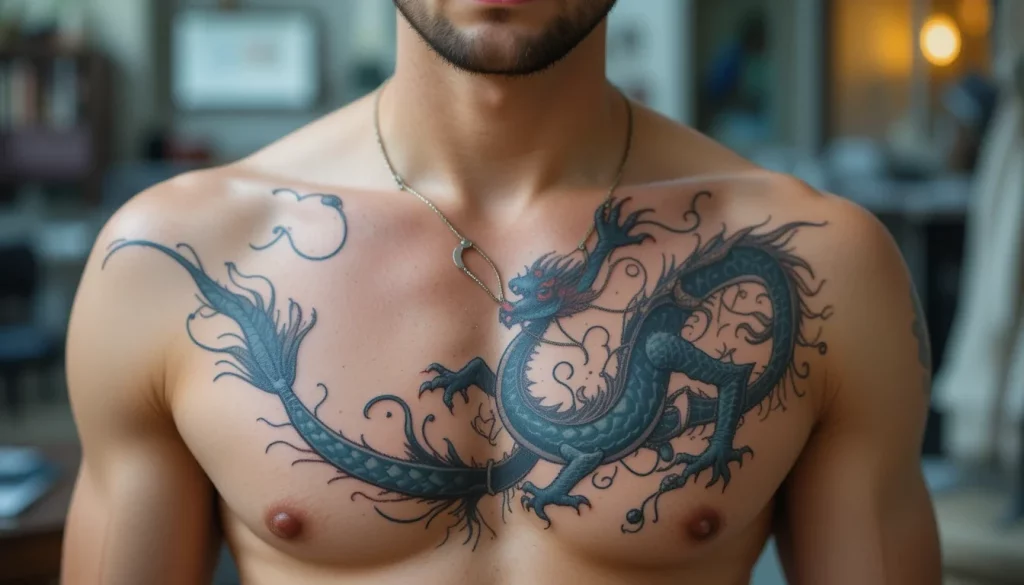
Conclusion
Water dragon tattoos are deeply meaningful symbols that resonate with individuals on various levels, from cultural significance to personal growth. The fluidity and duality represented by water dragons serve as powerful reminders of adaptability, strength, and creativity. Whether seen as auspicious symbols or personal transformations, the allure of these tattoos continues to grow, appealing to those seeking not just body art but connections to tradition, spirituality, and individuality.
FAQs
1. What does a water dragon tattoo symbolize in different cultures?
Water dragon tattoos symbolize adaptability, strength, and good fortune in Asian cultures, embodying the balance between creation and destruction.
2. Are there specific colors that are commonly used in water dragon tattoos?
Yes, water dragon tattoos often feature vibrant blues, greens, and turquoises, symbolizing water, along with other colors depending on the design.
3. Can water dragon tattoos have additional symbols?
Absolutely! Many people incorporate additional symbols like koi fish, lotus flowers, or clouds to enhance the tattoo’s meaning.
4. How long does it take for a water dragon tattoo to heal?
Typically, a tattoo heals within 2-4 weeks, but full healing may take longer. Following proper aftercare can speed up the healing process.
5. Is it necessary to follow up with a tattoo artist after getting inked?
Yes, it can be helpful to follow up with your tattoo artist for any concerns regarding healing or touch-ups after the tattoo has settled.
-

 Spiritual Meanings1 year ago
Spiritual Meanings1 year agoThe Spiritual Meaning of 20/20 Insights Into Numerology and Perception
-

 Spiritual Meanings1 year ago
Spiritual Meanings1 year agoThe Spiritual Meaning of the Left Side of the Body: Understanding Energy Flow and Symbolism
-

 Spiritual Meanings1 year ago
Spiritual Meanings1 year agoThe Spiritual Significance of a Baby Born Face Up
-

 Spiritual Meanings1 year ago
Spiritual Meanings1 year agoWhat is Aura Gold and How Can It Benefit You?
-
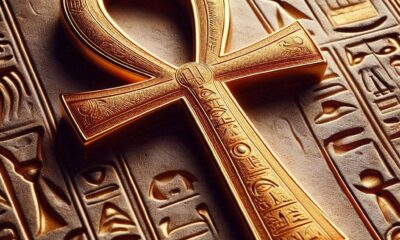
 Symbolism1 year ago
Symbolism1 year agoSpiritual meaning behind the ancient symbol of ankh
-

 Tattoos1 year ago
Tattoos1 year agoWhat is The Symbolic Meaning Behind Phoenix Tattoo?
-

 Spiritual Meanings1 year ago
Spiritual Meanings1 year agoThe Spiritual Significance of the Full Moon in Scorpio: What Does it Mean for Your Spiritual Journey?
-

 Spiritual Meanings1 year ago
Spiritual Meanings1 year agoThe Spiritual Symbolism of the Right Side of the Body





